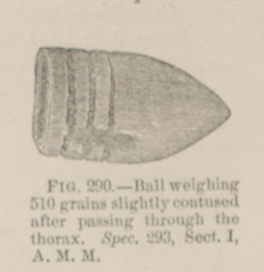Title: P——, J. J.
Source text: Surgeon General Joseph K. Barnes, United States Army, The Medical and Surgical History of the War of the Rebellion. (1861–65.), Part 1, Volume 2 (Washington, D.C.: Government Printing Office, 1870), 589.
Civil War Washington ID: med.d1e20334
TEI/XML: med.d1e20334.xml
CASE 19.—Private J. J. P——, Co. B, 5th Wisconsin Volunteers, aged 24 years, was wounded at Chancellorsville, May 3d, 1863, by a conoidal ball, which entered between the sixth and seventh ribs, an inch outward of the mammillary line, grazing and fracturing the seventh rib. He was treated in the field hospital, and, on May 8th, was transferred to Douglas Hospital, Washington. When admitted, the patient was suffering from very severe dyspnœa, accompanied by an incessant, painful, and annoying cough; respiration was very frequent, forced, and superficial, he stated that he had spat blood after the injury, but not the least tinge of blood was observable in the thick frothy mucous expectoration. An abundant effusion in the left thoracic cavity easily accounted for the dyspnœa. Purgatives, diaphoretics, and stimulants were administered and counter-irritants applied over the left side of the chest, with water dressings to the wound. He died May 10th, 1863. At the post-mortem examination, sixteen hours after death, old adhesions were found in the right lung and fresh ones in the left. The effusion of sero-sanguinolent fluid in the left cavity was the immediate cause of death. Paracentesis thoracis would have proved of but little avail, as the diaphragm was perforated and the spleen and left kidney badly bruised and injured. The ball lodged parallel to the transverse process of the fourth lumbar vertebra, near the spine. The case was exceedingly interesting, because the patient had manifested no abdominal symptoms, had no blood in his urine, and voided it freely and without pain in spite of the extensive injury to the left kidney. The case is reported by Acting Assistant Surgeon Carlos Carvallo. The missile, with the merest contusion of the rings at one point, was forwarded to the Army Medical Museum by Assistant Surgeon W. Thomson, U. S. A., and is represented in the adjoining wood-cut (FIG. 290).
